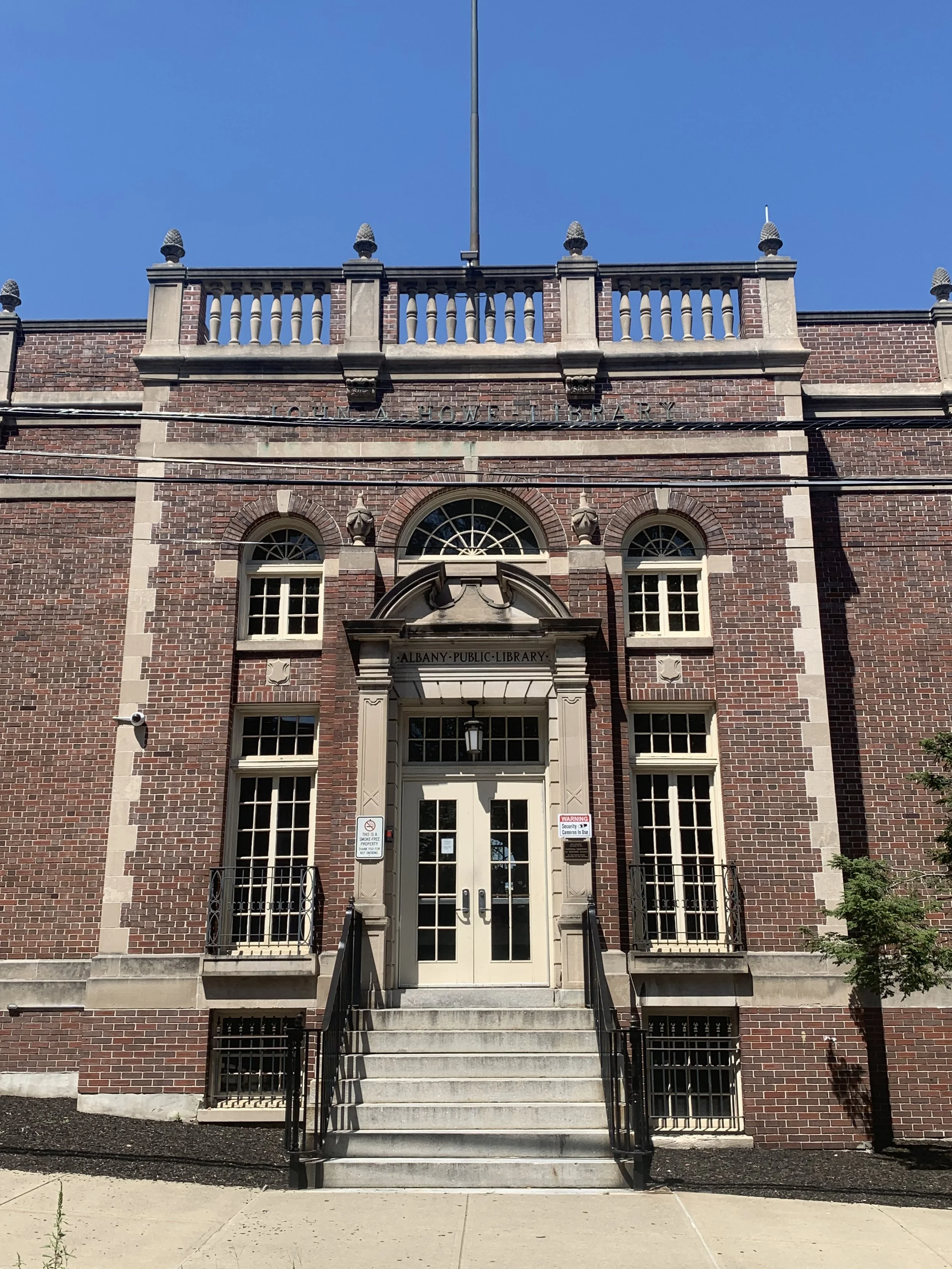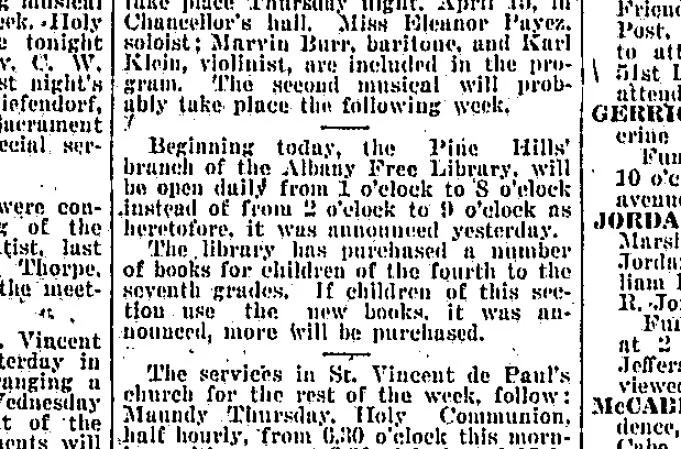#WhereinAlbany The Albany Public Library: Pine Hills and Howe Branches
/This year, the Albany Public Library (APL) is commemorating its 100th anniversary across all seven of its branches. Accordingly, the focus of this week’s #WhereinAlbany blog post will cover specific branches of the APL. This post touches on the history of the Howe and Pine Hills branches and how they have served the City of Albany throughout the years. The next blog will focus on different branches, with each blog following historic and contemporary themes such as socioeconomic inequality, city architecture, and the general importance of public libraries.
The expansion of public libraries in the United States can be attributed to a plethora of different factors which were oftentimes dependent on local circumstances. Generally, the development of public libraries coincided with the expansion of public education during the late nineteenth and early twentieth century. The growth of educational infrastructure was a key reform championed by Progressive Era advocates. During the late nineteenth century, rapid urbanization and the growth of an influential middle/working class caused an increased demand for educational activities. Furthermore, the rise of a wealthy, business-owning class led to high levels of philanthropic activities, of which a large portion of the funds were directed to public libraries. Increasingly complex institutions, urbanization, and industrialization led to a societal shift that encouraged the development of public resources.
Equally as important is the role of city, state, and federal governments in instituting free libraries. Many public libraries were initially constructed as “social libraries” and extensions of schools acting as corporations. These libraries heavily relied on paid memberships and donors to continue operating. As members of these social libraries lost interest in their endeavors, the community often turned to local or town governments, thus transforming the collection into a free library.
Howe branch of the albany public library - front entrance (taken 7/20/23)
Howe branch’s refurbished arched windows (taken 7/20/23)
Howe branch’s fireplace mantle in the children’s room (taken 7/20/23)
This is the case for the Howe Branch, which was first established in 1891 by School No. 1 principle John A Howe. Two years later, the school was converted into a free library and changed locations to the corner of Bassett and S. Pearl Street. The library, however, was not incorporated as a branch of the APL until 1929. As the oldest continually operating library in the City of Albany, the Howe Branch has been an instrumental resource for the South End neighborhood. Notably, the Branch has historically been popular with young people in the neighborhood. During times of depression, when lack of funding restricted other activities, the library tended to be a popular meeting place for the local teenage population.
In 2008, the Albany Public Library began to implement an improvement plan across all of its branches. The Howe Branch underwent a series of renovations during the improvement plan which aimed to not only improve the library’s services but also to preserve the building’s historic features. The Howe Library was originally designed by local architect Howard Rogers. The building style chosen was Georgian Revival, with the primary materials used being Harvard Brick and Indiana limestone. Most of the building’s renovations tend to focus on the building’s interior design. The children’s fireplace mantle, which features tiles depicting the story of Rip Van Winkle, is a major example of this. Plaster walls were painted to period-accurate colors, original bookshelves were restored to working condition, and turned oak columns were preserved at the entrance. The preservation of the building's large arched windows is one of the most important aspects of the renovation. This facet allows natural light to flood into the building, increasing energy efficiency. The project received the Preservation Merit Award from the Historic Albany Foundation and the Historic Preservation/Adaptive Reuse Merit Award from the American Institute of Architects.
The improvement plan was not purely aesthetic, and the Howe branch received new software and an expanded collection to tailor to the neighborhood’s needs. For example, cultural material such as Spanish language learning was added to the branch’s collection alongside African American material. Due to the building’s proximity to Schuyler Mansion, the branch was also given extra material on the American War of Independence. Likewise, the Pine Hills branch also received valuable renovations. Both buildings are LEED-certified, meaning that the branches operate sustainably whilst avoiding inefficient energy usage.
Pine Hills
The Public Library system has served the Pine Hills neighborhood since 1900, though the branch has changed locations multiple times since then. The first free library in Pine Hills was located on Ontario Street, close to its intersection with Madison Avenue. Located below is an excerpt from a newspaper on April 1st, 1920, showing the Pine Hills branch advertising its updated hours. From 1952 to 1991, the branch was situated at 1000 Madison Avenue. This Colonial Revival style building was constructed in 1899 and was originally home to Henry C. Dumary, who was president of the Helderberg Cement Company. A series of families cycled through the home until 1951 when Sal Levi, vice president of the Mohawk Brush Company, sold the property. It was then that the Albany Public Library renovated the structure for usage. The house features clapboard siding with a brick base, which is characteristic of homes in the area. In addition, the structure has stained glass windows and a Queen Anne tower.
In 1991 the Pine Hills branch was then relocated to 517 Western Avenue, a brick Art Deco building that previously served as offices for the New York Telephone company. 1000 Madison has since been renovated into offices for the College of Saint Rose. The library remains at 517 Western today and continues to be an invaluable public resource for the Pine Hills community.
1000 Madison ave inventory sheet - provided by cultural resource information system
1000 madison ave inventory sheet - provided by cultural resource information system
Pine hills blurb Apr 1, 1920 - The Argus (image provided by the new york state library)
Howe branch renovations apr 19, 2010 - capital neighbors (image provided by the albany public library)
By Liam Kelley
Michael Kevane, William A. Sundstrom: The Development of Public Libraries in the United States, 1870-1930: A Quantitative Assessment
1000 Madison Ave Inventory Sheet link
Waite, Diana S. Albany Architecture. New York: Mount Ida Press, 1993.
Albany City Directories: 1899 - 1992







